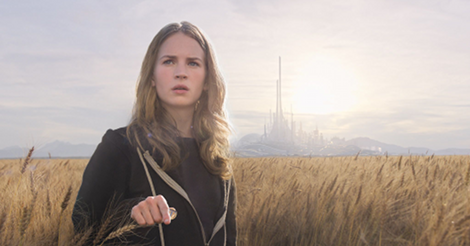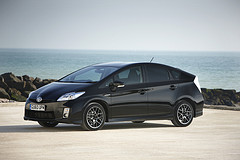
Note: I’m departing a bit from my usual schedule to bring you another sci-fi movie review, this time for Tomorrowland; there will be spoilers. I consider these films to be both contributions to and barometers of the public science conversation.
As I watched Tomorrowland with my kids, I kept coming back to the increasingly puzzling notion that it had been “refuted” by Mad Max: Fury Road. While I can certainly understand how a post-apocalyptic story can have a hopeful subtext, I don’t see why we can’t also have stories which are textually hopeful. There’s the trivial reality that Tomorrowland is a film I can watch and discuss with my under-10 children while still being a bit challenging for them. More substantially, I think it’s fascinating that the article engages with a quote about Tomorrowland‘s possible nostalgic inspiration more than the film itself, which isn’t about nostalgia at all. In doing so, it actually manages to underscore the film’s theme that how a message is framed strongly influences how we respond to the message itself.
To be fair, the film has a number of elements from science fiction’s past, but the narrative draws us away from that world, not further into it. The most nostalgic element of the film is a store specializing in the ephemera of science fiction from the 50s through the 80s, but its proprietors are quickly revealed to be henchmen of the villain and shortly afterwards, the store is blown up. There is a world modeled after the Tomorrowland of the Disney theme parks and World’s Fair exhibit, complete with jet packs, but again, that is operated by the villain and by the end of the story it has been remade to serve the present, not the future of the past.
If anything, there’s more of a sense of nostalgia for science fact rather than science fiction. The heroine, Casey (Britt Robertson), is the daughter of a NASA engineer. We meet her sabotaging the equipment dismantling the space shuttle program; she can’t accept that the triumphs of that program are inaccessibly in her past. When she can’t prevent the launchpad from coming down, she clings to her father’s NASA hat as her last connection to a dream of a future that will never exist. So when she lets go of the hat during the climactic action sequence, it’s our signal that she is finally able to embrace the actual future.
True, there are some critical comments about pessimistic visions of the future made by several characters. But the critique is focused on how fear is used when reporting science topics like climate change. It is these bleak visions of our actual future that the film is most concerned with; it explicitly describes bleak science fiction as a side effect, not the core problem. There’s room for discussion on whether that’s an accurate assessment, but either way, Tomorrowland doesn’t claim that just changing the kind of science fiction we tell will be enough to address the concerns it has.
Tomorrowland is most concerned with human psychology. Humans can be strongly motivated by fear, but some outcomes are easier to achieve with a fear-based motivation than others. Emotional responses are instinctive; we don’t have complete control over how they are wired and which emotions trigger which responses. Fear tends to be linked to a fight-or-flight reaction. It can make us aggressive, driving us to lash out. That’s how we see Casey deal with her fear at first, by striking at the deconstruction effort at NASA. Fear can also make us retreat, seeking shelter and avoiding risk (“Once bitten, twice shy.”). This is Frank’s (George Clooney) solution; he begins the story as a recluse in an isolated cabin with redundant locks and security systems.

 )
)Underlining the instinctual nature of emotional responses is the treatment of robots in the film. As is common in science fiction, robots are initially treated as less than human because they are mechanical and automated, no matter how many human characteristics or how much personality they display. A lot of emphasis is placed on the programmed nature of the robots and the lack of emotions as the attributes that distinguish them from humans. Yet, at the end at least one robot is accepted by the human heroes as a peer. Given the examination of instinctive fear responses, I read this as a recognition that humans can be just as automated as robots. Emotions are not what separate us from robots; our emotional responses are the most robotic thing about humans!
Both parts of our fear response have their time and place, but fear isn’t everything. It may get people to buy insurance or alarm systems, products that appeal to the risk-avoidance instincts elicited by fear. But when you need people to trust each other, to work together, to make sacrifices in the present for possible benefits in the future — all of which involve risk — then fear is unlikely to get that reaction. And we’re going to have to trust each other and work together to confront issues like climate change, according to Tomorrowland.
I think that’s why the Bible has so much to say about fear, specifically encouraging us not to be afraid in numerous passages. Loving your neighbor is risky. Turning the other cheek is risky. Giving resources to widows and orphans is risky. Building a community is risky. These are not activities for the timid and fearful. True, the Bible does have a dose of an apocalyptic future, but even the book of Revelation ends with a wedding feast, a hopeful celebration of the risk-taking involved in making a lifelong commitment to another person.
So, if fear isn’t the right motivation, what is? Tomorrowland proposes hope and inspiration. There may be a role for more utopian science fiction as part of that motivation, but the film also acknowledges its limitations. Frank was disillusioned because the future he was promised never materialized, revealing how fiction can be demotivating. Ultimately, a greater emphasis is placed on accomplishing progress in the real world, rather than just imagining it. Here again, I think God would agree. His ultimate plan to motivate us wasn’t telling a nice story about heaven; he rolled up his sleeves, became incarnate as a human and did the work necessary to bring glimpses of the kingdom of God to Earth.
Andy has worn many hats in his life. He knows this is a dreadfully clichéd notion, but since it is also literally true he uses it anyway. Among his current metaphorical hats: husband of one wife, father of two teenagers, reader of science fiction and science fact, enthusiast of contemporary symphonic music, and chief science officer. Previous metaphorical hats include: comp bio postdoc, molecular biology grad student, InterVarsity chapter president (that one came with a literal hat), music store clerk, house painter, and mosquito trapper. Among his more unique literal hats: British bobby, captain’s hats (of varying levels of authenticity) of several specific vessels, a deerstalker from 221B Baker St, and a railroad engineer’s cap. His monthly Science in Review is drawn from his weekly Science Corner posts — Wednesdays, 8am (Eastern) on the Emerging Scholars Network Blog. His book Faith across the Multiverse is available from Hendrickson.

Leave a Reply